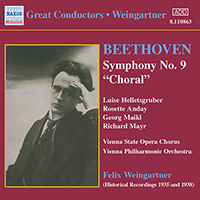| This is my post from this week's Tuesday Blog. |
To conclude our #Beethoven2020 series on the Tuesday Blog, we consider Beethoven’s Choral Symphony and Consecration of the House overture, which were both premiered at the same concert, on 7 May 1824.
The recording I selected today is a historic recording featuring Felix Weingartner, a contemporary to Mahler and Toscanini in one of the earliest available recordings of this seminal work . Weingartner was respected as much for his musical scholarship as his conducting. In 1906, he proposed a monograph on the performance of Beethoven symphonies that in some respects became the progenitor of new editorial research on the composer leading to the radical quests of period instrument performance in the latter part of the twentieth century.
Weingartner’s mastery of instrumental balance is expertly demonstrated in the brief processional march following the opening ceremonies of the overture The Consecration of the House. Weaving through emphatic chordal interjections, the chattering bassoon commentary that is so often garbled or lost within the texture altogether, here very audibly urges the rest of the orchestra on towards the main Allegro. The conductor transforms a passage of potential idiosyncrasy into something both apposite and wickedly jaunty. Composed to introduce a revised version of The Ruins of Athens incidental music for the opening of the Josephstadt Theater in 1822, not long before work began in earnest on the Missa Solemnis and the Ninth Symphony, it is dressed by Weingartner in suitably festive colours with much élan.
Weingartner's 1935 Vienna recording of the Choral Symphony is without doubt one of the highlights of the recorded canon. The Vienna Philharmonic Orchestra is showing all the signs both of its long heritage and also of becoming a well-disciplined modern orchestra in the new era of full orchestral recordings that began just ten years earlier with the first use of the microphone in the electrical recording method. The Vienna State Opera Choir is of course superb, as is the almost ideal quartet of soloists heard here.
Sonically this is without doubt a mid-1930s recording. Worse than that, the final movement was recorded separately and sounded completely different in its tonal balance to the rest of the recording. Audio emgineers post-processed the masters, both to resurrect the overall sound quality, counteracting the multiple discrepancies introduced by 1930's recording methods, and also to bring the finale closer in tone to the rest of the recording.
Happy Listening!

Ludwig van BEETHOVEN (1770-1827)
Die Weihe des Hauses Overture, Op. 124
London Philharmonic Orchestra
Recorded 7th October 1938 in EMI Abbey Road Studio No. 1, London
Matrices: CAX 8354-1, 8355-1 and 8356-1
First issued on Columbia LX 811 and 812
Symphony No. 9 in D Minor, Op. 125 “Choral”:
Luise Helletsgruber, Soprano
Rosette Anday, Contralto
Georg Maikl, Tenor
Richard Mayr, Bass
Vienna State Opera Chorus
Vienna Philharmonic Orchestra
Recorded 2nd - 4th February 1935 in the Mittlerer Konzerthaussaal, Vienna
Matrices: CHAX 61-3A, 62-3A, 63-3A, 64-3A, 65-1A, 66-2A, 67-2A,
68-2A, 69-2, 70-2A, 71-4A, 72-3A, 73-2, 74-1, 75-2, 76-2A
First issued on Columbia LX 413 through 420
Conductor Felix Weingartner
Label: Naxos Historical
Catalogue No: 8.110863
See Naxos Page - https://www.naxos.com/catalogue/item..._code=8.110863
Internet Archive - https://archive.org/details/beethoven-consecration-overture

No comments:
Post a Comment